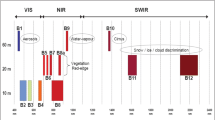Abstract
In this paper, we develop a classification method of land cover based on support vector machines. As a case study, we choose five Landsat images to retrieve land cover maps in Shenzhen, China from 1979 to 2005. The classification method is based on support vector machines with assistance from visual interpretation. And then we take use of the complex network approach to analyze the character of land use-cover change from an overall perspective. The result shows that the main changes of land use-cover are different over time. The medium of bare land during the urban construction can hardly be witnessed, even though the time intervals are shorter than the two periods before. It reveals the transformation from vegetation to urban becomes faster. The transformation from vegetation to bare land is hard to be witnessed in the late stage. As bare land is the medium for transforming vegetation to urban land in Shenzhen during the past years from 1979 to 2005.
Access this chapter
Tax calculation will be finalised at checkout
Purchases are for personal use only
Similar content being viewed by others
References
Benning, T.L., LaPointe, D., Atkinson, C.T., Vitousek, P.M.: Interactions of climate change with biological invasions and land use in the hawaiian islands: modeling the fate of endemic birds using a geographic information system. Proc. Natl. Acad. Sci. 99, 14246–14249 (2002)
Reid, R., et al.: Land-use and land-cover dynamics in response to changes in climatic, biological and socio-political forces: the case of southwestern ethiopia. Landscape Ecol. 15, 339–355 (2000)
Kreuter, U.P., Harris, H.G., Matlock, M.D., Lacey, R.E.: Change in ecosystem service values in the san antonio area, texas. Ecol. Econ. 39, 333–346 (2001)
Moran, E.F.: News on the land project. Glob. Change Newsl. 54, 19–21 (2003)
Turner, B.L., Meyer, W.B., Skole, D.L.: Global land-use/land-cover change: towards an integrated study. Ambio 23, 91–95 (1994)
Dewan, A.M., Yamaguchi, Y.: Using remote sensing and gis to detect and monitor land use and land cover change in dhaka metropolitan of bangladesh during 1960–2005. Environ. Monit. Assess. 150, 237–249 (2009)
Yin, J., et al.: Monitoring urban expansion and land use/land cover changes of shanghai metropolitan area during the transitional economy (1979–2009) in China. Environ. Monit. Assess. 177, 609–621 (2011)
Lambin, E.F., et al.: The causes of land-use and land-cover change: moving beyond the myths. Glob. Environ. Change 11, 261–269 (2001)
Schaldach, R., et al.: An integrated approach to modelling land-use change on continental and global scales. Environ. Model Softw. 26, 1041–1051 (2011)
Seto, K.C., Kaufmann, R.K.: Modeling the drivers of urban land use change in the pearl river delta, China: integrating remote sensing with socioeconomic data. Land Econ. 2003(79), 106–121 (2003)
Seto, K.C., Fragkias, M.: Quantifying spatiotemporal patterns of urban land-use change in four cities of China with time series landscape metrics. Landscape Ecol. 20, 871–888 (2005)
Li, X., Yeh, A.G.-O.: Analyzing spatial restructuring of land use patterns in a fast growing region using remote sensing and gis. Landscape Urban Plan. 69, 335–354 (2004)
Sui, D.Z., Zeng, H.: Modeling the dynamics of landscape structure in Asia’s emerging desakota regions: a case study in Shenzhen. Landscape Urban Plan. 53, 37–52 (2001)
Yang, Q., Li, X., Shi, X.: Cellular automata for simulating land use changes based on support vector machines. Comput. Geosci. 34, 592–602 (2008)
Farr, T.G., et al.: The shuttle radar topography mission. Rev. Geophys. 45(RG2004), 1–33 (2007)
Nordkvist, K., Granholm, A.-H., Holmgren, J., Olsson, H., Nilsson, M.: Combining optical satellite data and airborne laser scanner data for vegetation classification. Remote Sens. Lett. 3, 393–401 (2011)
Friedl, M.A., Brodley, C.E.: Decision tree classification of land cover from remotely sensed data. Remote Sens. Environ. 61, 399–409 (1997)
Franco-Lopez, H., Ek, A.R., Bauer, M.E.: Estimation and mapping of forest stand density, volume, and cover type using the k-nearest neighbors method. Remote Sens. Environ. 77, 251–274 (2001)
Yanfei, Z., Liangpei, Z.: An adaptive artificial immune network for supervised classification of multi-/hyperspectral remote sensing imagery. IEEE Trans. Geosci. Remote Sens. 50, 894–909 (2012)
Mountrakis, G., Im, J., Ogole, C.: Support vector machines in remote sensing: a review. ISPRS J. Photogram. Remote Sens. 66, 247–259 (2011)
Pal, M., Mather, P.: Support vector machines for classification in remote sensing. Int. J. Remote Sens. 26, 1007–1011 (2005)
Pengfei, W., Huili, G., Demin, Z.: Land use and land cover change in watershed of guanting reservoir based on complex network. Acta Geogr. Sin. 67, 113–121 (2012)
Yang, C., et al.: Spatiotemporal evolution of urban agglomerations in four major bay areas of US, China and Japan from 1987 to 2017: evidence from remote sensing images. Sci. Total Environ. 671(25), 232–247 (2019)
Acknowledgments
This work was supported in part by the Basic and Applied Basic Research Funding Program of Guangdong Province of China (Grant No. 2019A1515110303), the Natural Science Foundation of Guangdong Province (Grant No. 2018A030313014), the research team project of Dongguan University of Technology (Grant No. TDY-B2019009), the Guangdong University Key Project (2019KZDXM012).
Author information
Authors and Affiliations
Corresponding author
Editor information
Editors and Affiliations
Rights and permissions
Copyright information
© 2020 Springer Nature Switzerland AG
About this paper
Cite this paper
Ding, K., Wang, C., Tao, M., Xiao, H., Yang, C., Huang, P. (2020). A Classification Method of Land Cover Based on Support Vector Machines. In: Chen, X., Yan, H., Yan, Q., Zhang, X. (eds) Machine Learning for Cyber Security. ML4CS 2020. Lecture Notes in Computer Science(), vol 12488. Springer, Cham. https://doi.org/10.1007/978-3-030-62463-7_5
Download citation
DOI: https://doi.org/10.1007/978-3-030-62463-7_5
Published:
Publisher Name: Springer, Cham
Print ISBN: 978-3-030-62462-0
Online ISBN: 978-3-030-62463-7
eBook Packages: Computer ScienceComputer Science (R0)




